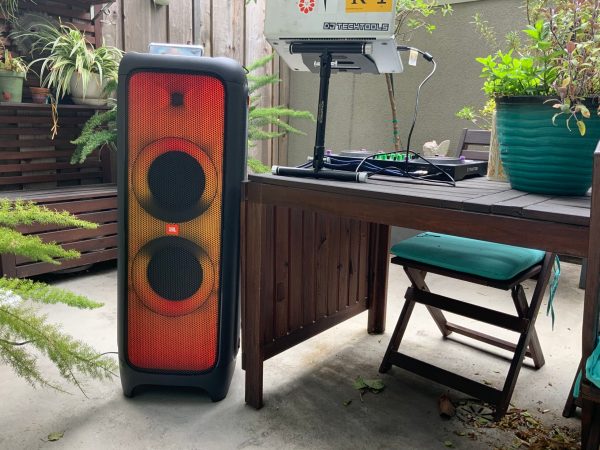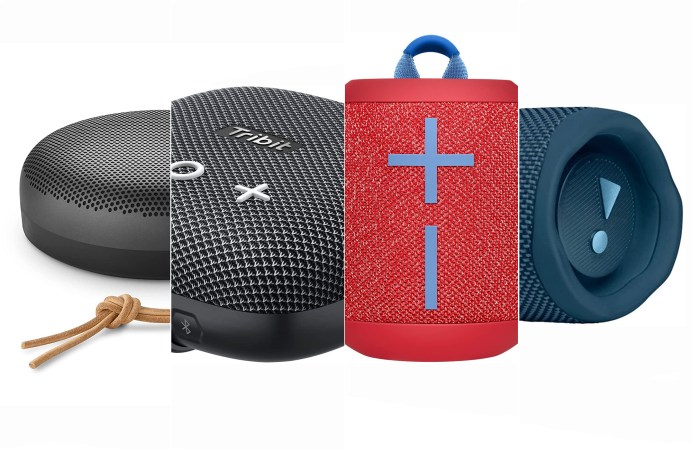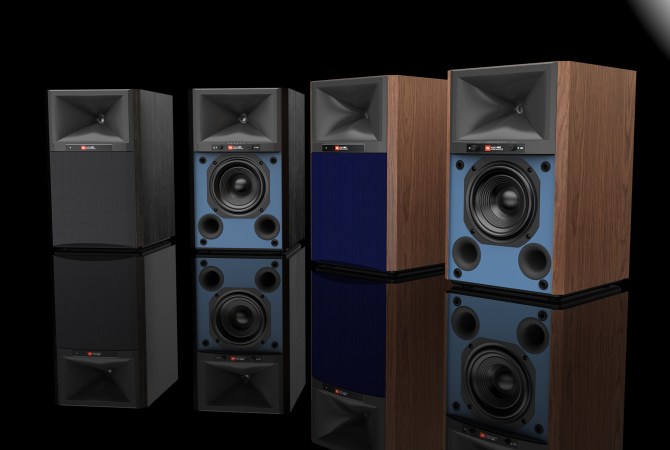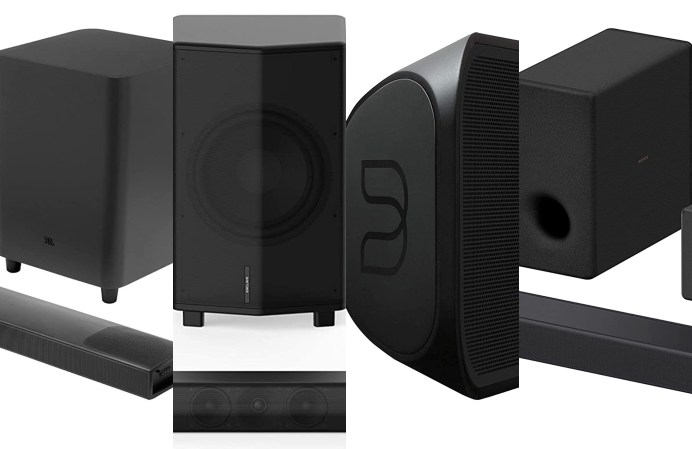

We may earn revenue from the products available on this page and participate in affiliate programs. Learn more ›
With all the at-home “partying” over the last year-and-a-half, loudspeaker manufacturer JBL may have had a hard time keeping up with the demand for its existing line of Bluetooth “party speakers,” which offer premium choices in a sea of alternatives that barely pass the eye test, let alone the ear test. Yet, instead of just putting production on repeat, the company wisely added to its line with the JBL PartyBox 110, a generous update to the popular, mid-sized PartyBox 100. With a striking new light show, substantial battery power, mobile app control, a splash-proof body, and wireless stereo pairing with a second speaker, the PartyBox 110’s features make a compelling argument that it deserves a spot on the more powerful end of the best portable Bluetooth speakers. And it sounds at least as good as it looks. To get the party started, just add beats and bodies. Let’s look at how the PartyBox 110 can satisfy a crowd or an intimate audience looking to sweat worries away.
Large Sound, Portable Body
JBL PartyBox 110 design
Whereas the flagship JBL PartyBox 1000 is an imposing slab of sound for serious blockrocking (and serious coin at over a grand), its mini-me the PartyBox 110 is a much more approachable package. Weighing in at 23 pounds and measuring 22.4-inches tall by 15.3-inches wide by 15.6-inches deep, the 160W loudspeaker is fairly large and powerful, but still portable enough for most people to handily transport it to the backyard, beach, barbecue, or what have you. Two built-in handles, one at each end of the speaker, make it easier to lug the sturdy enclosure, which features two 5.25-inch woofers (rear-ported) and two 2.25-inch tweeters to deliver a frequency response of 45 Hz – 20 kHz (which adds some highs to the PartyBox 100’s 18 kHz rating).
The PartyBox 110 features a full-spectrum light show on the face of the speaker behind its protective grated metal enclosure—a hallmark of the entire JBL PartyBox speaker line. While it’s not the full-faced light show of the PartyBox 1000, the PartyBox 110 does step up the visual game from the other smaller JBL units. Instead of two circular lights around the woofers, the PartyBox 110 now has a fuller, figure-8 lighted area around the woofers, as well as two additional small lighted circles around the tweeters in the center of the speaker and two flashing strobe lights at either end. The RGB lights are beat-synced to incoming music and you can select from five light-motion patterns or turn off the lights from either the controls on top of the speaker or the JBL PartyBox app (a free download for iOS and Android).
Because celebrations shall know no bounds, the JBL PartyBox 110 is officially IPX4, making it pool-party appropriate. IPX4 means it is protected from splashes of water coming from any direction, as well as spraying water and vertically falling water drops. However, for the sake of what isn’t an insubstantial investment, don’t mistake that for being fully waterproof. The IEC’s ingress protection (IP) ratings go all the way up to IPX9 and, according to those ratings, the PartyBox 110 is not protected against water projected in jets or any amount of immersion in water. Take it to the pool, not with you into the pool.
As for where around the pool, patio, etc., you can place it, the answer is pretty much anywhere. The JBL PartyBox 110 has four rubber pads on its bottom side for standing it up vertically. It’s also designed to be placed horizontally; both of its sides have sets of stiff orange rubber feet for setting it on either side without scraping the plastic enclosure. You can also mount the speaker to standard PA speaker stands. A removable plastic cap on the bottom of the unit conceals the PA stand-mounting holes.

Getting started with the JBL PartyBox 110
In keeping with its splash-proof status, the JBL PartyBox 110’s back-side audio inputs and controls, as well as its power-cable port, are protected with a sealable rubber covering that you pull back to access. The speaker includes a 36Wh Li-ion rechargeable battery and a “figure-8” AC power cord. Charging takes about 3.5 hours for an advertised 12 hours of playback time (that’s almost twice as fast as the PartyBox 100). An LED strip on the top panel shows the battery charge level. In my tests, I got more than 10 hours of battery playback with a full charge before a low-power alert sound played and the power bar flashed red—and that was while playing over Bluetooth at various volume levels with the light show on the whole time.
When you power up the speaker from the top-panel button, the JBL PartyBox 110 goes immediately into wireless pairing mode, and I easily connected to “JBL PartyBox 110” over the Bluetooth 5.1 connection on a Mac laptop, iPad, and Android phone. You can also play audio through the stereo 3.5mm (minijack) aux input or from a USB stick loaded with MP3, WMA, and/or WAV files. It will play audio from only one of these sources at a time. If connecting a USB stick, it automatically starts playback in alphabetical order of the compatible audio file names.
Key features of the JBL PartyBox 110
The additional lighting elements that the PartyBox 110 boasts over the other JBLs like the PartyBox 100 or PartyBox 310 do make it more visually compelling and add an extra flair to the beat-synced patterns. Five such patterns offer various permutations of spinning, flashing, flowing, and color morphing.
While the PartyBox 110 is an audiovisual experience, the coolest lights in the galaxy would not save a party from crappy sound. Luckily, you won’t have to sweat that with the PartyBox 110, because it’s loaded with JBL Original Pro Sound—much of the same audio technology that JBL packs into its professional PA loudspeakers.
There’s no option to EQ, but the JBL PartyBox 110 does have two levels of Bass Boost, which you can cycle through (off/low/high) with the top-panel button. The other audio control includes a volume dial and a play/pause button for controlling the playback from a USB stick or the Bluetooth device. Pressing it twice quickly skips to the next track. On the back panel, two 1/4-inch audio inputs with volume knobs let you plug in a microphone and/or a guitar for people to either sing and play along with music or just for solo performances. The Mic input includes some “echo” on it by default, which sounds more like a reverb effect to me. The Guitar input does not add any effect on its sound but it also worked fine for a microphone if you want to sing duets from two mics.
The JBL PartyBox 110’s wattage is 160W RMS (root mean square), meaning that it can reliably sustain 160W of continuous power but reach peak levels even higher than that. So while it can’t hold a candle to the PartyBox 1000’s 1100W (which might blow out that candle with its bass), the PartyBox 110 is still a fairly boomin’ little system. However, if that’s still not enough for you, or if you just want to listen to a true stereo system, you can wirelessly pair two PartyBox 110 speakers with each other.

It takes two to make a thing go right
I did, in fact, test two JBL PartyBox 110 speakers together with great results. All you have to do is power up both speakers and then press the TWS (True Wireless Stereo) button from the back panel of each speaker one after the other. An indicator sound lets you know that the TWS pairing is underway. (Other alert sounds indicate when the speaker powers up, powers down, or is pairing over Bluetooth.) The two speakers should be located within standard Bluetooth range of each other: a maximum distance of around 33 feet.
Once you wirelessly connect both speakers, they play back just like any other pair of stereo speakers. Their light shows also stay perfectly in sync with each other. And the controls on each speaker will operate both units, so adjusting the volume, the light show setting, or the Bass Boost setting on either speaker affects both units. Only the power button stays independent, so you can turn off one paired speaker without shutting off the other.
As the TWS name suggests, syncing two PartyBox speakers from the hardware button links them together as a stereo pair, so that one speaker plays the left channel of the audio source and the other plays the right channel. However, using the app unlocks quite a few features of the PartyBox 110 not available from the hardware controls, such as switching the TWS mode so that both speakers play both the left and right channels of the music.
Party rockin’: There’s an app for that
To control the speaker with the JBL PartyBox app, you must first pair the mobile device to the speaker over Bluetooth. As mentioned, the app’s TWS screen can set both speakers to play both the left and right channels of the music, which could be preferable to the stereo mode if instead of placing the speakers side-by-side, you place them in opposite corners of a room or a yard so that they cover more territory. When they are in TWS stereo mode, the app can switch the L/R status of the two speakers.
Through the app you can choose the light show patterns, but you also get greater control over the lights. For instance, you can turn off or on the three elements of the light show: the main figure-8 lights, the small circular lights around the tweeters, and the two strobe lights. It’s nice to have the option to turn off the strobes, because even for people who do not have physiological reactions to them, they can become annoying after prolonged periods of time. The app also allows you to change the light show color from the default setting that morphs between the colors of the rainbow to any static color, including white. And buttons for nine “Free style” lighting effects take over the speakers’ lights with progressively rapid patterns for as long as you press them.
A DJ Effect screen offers another nine buttons that play sound effects from the JBL PartyBox, including vinyl scratching sounds, applause, boos, and the iconic, never-not-awesome airhorn. The Karaoke screen only applies when you’re using the speaker’s Mic input and it adjusts the bass and treble settings on your voice, as well as attenuates or turns off the Echo setting.
Finally, the app shows the battery charge level as a percentage rather than the less specific power bar on the hardware. And the app has the same playback controls (play/pause and skip track forward) as on the hardware. That seems like an opportunity for the app to have deeper playback controls, such as skip track backward, fast forward, and rewind, but perhaps JBL will add those in an update. The app also handles firmware updates to the PartyBox 110 so, all told, it’s an important companion to the speaker rather than just an optional accessory.

The boom for your bash
While not as thunderously loud as the JBL PartyBox 1000, one of the best-sounding Bluetooth speakers I’ve heard, the PartyBox 110 still retains the excellent sound quality of its larger sibling, which you may not expect from a party speaker if you presume such things to be little more than gimmicks for karaoke sessions. Rather, true to JBL’s promise of pro sound, the PartyBox 110 exhibits balanced and smooth bass, clear mid-range frequencies, and crisp but not harsh high frequencies.
I gave over my music-addicted lifestyle to the two speakers in stereo mode, throwing at them hefty portions of ’80s new wave, ’90s alternative, and recently released indie pop, hip-hop, trap, and electronic music mainly of the house, nu-disco, and dubstep varieties. The speakers dealt with every genre evenly, revealing details accurately across the frequency range. For example, when cranking the Bass Boost up to high on my favorite Psymbionic glitch-step tracks, the kick drums boomed and swelled but did not drown out or overshadow the pulsating and gyrating synth basslines. And on near-polar opposite material—the early Brit-rock of The Smiths, for example, which is more mid-range heavy—the low setting of Bass Boost was more appropriate and the simultaneous tones of the jangling guitars, crashing cymbals, organ, and vocals all occupied their own easily heard space.
As compared to the PartyBox 1000, which has a 12-inch subwoofer and frequency range extending to 30Hz, the JBL PartyBox 110 has smaller woofers and bottoms out at 45Hz, an audible difference. So it doesn’t have the same shelf-rattling low-end vibes that can send precariously placed wine glasses tumbling to the floor. But bassheads can still find satisfaction in the Bass Boost function. Its lower level of bass enhancement worked well maintaining relatively neutral dynamics on any style of music, while the higher level occasionally sounded a little artificial on genres not particularly mixed for it, like various flavors of rock music. However, on music made for the bass to be felt as well as heard, the high Bass Boost can really help lay that extra thump on your chest.
While testing tracks, I compared some 24-bit/44.1 kHz WAV files played through the JBL PartyBox 110 over both Bluetooth and the Aux In cable, but I didn’t detect any difference in sound quality between the two. The relative volume level was slightly lower on the Aux In, but all the audio details and the definition of sounds across the low, mid, and high frequencies remained the same. I did default to using the Aux In when monitoring DJ sets from my PartyBox 110 pair, however, in order to avoid the audio latency from the Bluetooth connection. And, in doing so, I ended up preferring the JBL party speakers over my usual DJ speakers, the KRK Rokit 6 G2 studio monitors. The PartyBox 110 speakers had a more powerful output and a more clearly defined and separated low-end than the Rokit 6, which occasionally muddies up the bass a little bit.
So, who should buy the JBL PartyBox 110?
For those seeking the best portable Bluetooth speaker for indoor/outdoor parties or small-sized DJ gigs, karaoke gatherings, or musical performances, the PartyBox 110 has the lit-up looks, solid sound, and extensive battery life to keep the tunes pumping in style. Its splash-proof design, remote app control, and PA speaker stand compatibility add to the appeal. Its larger singling, the JBL PartyBox 1000 delivers an absolutely huge sound with a beautiful full-surface light show, but its price and presence are overkill for many purposes. Personally, I’d rather have two PartyBox 110s working in stereo for less money than a single PartyBox 1000. Meeting them somewhere in the middle is the JBL PartyBox 310, which has the splash-proof design, app control, rechargeable battery, and a more powerful 240W, but the PartyBox 110 costs a bill less and has the updated, more impressive light show. The JBL PartyBox 110 wraps all of the company’s technological delights—including professional-level loudspeaker sound—into one mid-sized package, making it the portable speaker best suited to most merriment needs, whether it’s a full-on fiesta or a party of one.
























